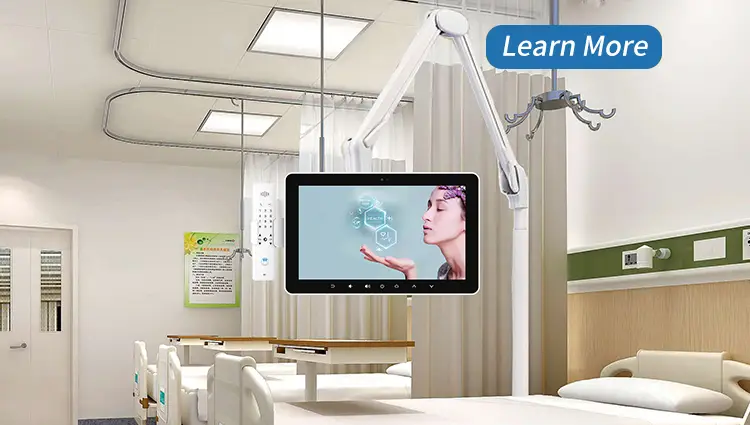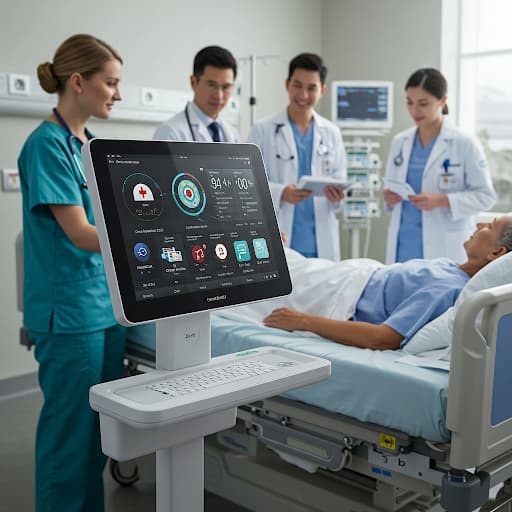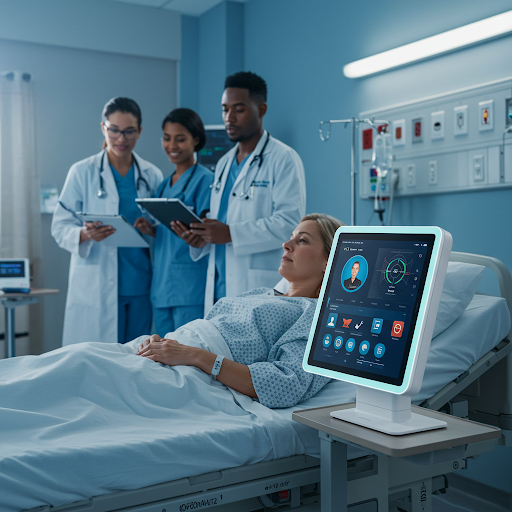In the fast-evolving landscape of healthcare, hospitals face mounting pressure to improve patient outcomes while reducing operational costs. One innovative solution gaining traction is the integration of smart terminals at patient bedsides. These multifunctional devices combine entertainment, communication, and clinical tools into a single platform, addressing challenges like staff burnout, patient isolation, and inefficient workflows.
1. Elevating Patient Experience & Satisfaction
A Gateway to Personalized Care
Modern patients expect the same connectivity and convenience they enjoy at home. A smart terminal meets these demands by offering:
- Entertainment on Demand: Stream Netflix, Spotify, or podcasts to reduce boredom and anxiety during long stays (a top concern in “hospital patient satisfaction surveys”).
- Real-Time Communication: Patients can video-call family, request pain relief, or order meals without waiting for rounds.
- Educational Resources: Access to condition-specific videos or post-op care instructions improves health literacy.
A 2023 study by the Journal of Medical Internet Research found that hospitals using bedside terminals saw a 32% increase in patient satisfaction scores, directly impacting HCAHPS ratings and reimbursement rates.
(Photo from internet)
2. Streamlining Clinical Workflows
Reducing Cognitive Load for Healthcare Staff
Smart terminals integrate seamlessly with EHR systems, allowing nurses to update records, track vitals, and set medication reminders at the bedside. This eliminates redundant data entry and minimizes errors—critical for meeting “hospital IoT compliance standards.”
For example, Mercy Hospital St. Louis reported a 22% reduction in administrative tasks after deploying smart terminals, freeing nurses to prioritize direct patient care.
3. Real-Time Data Monitoring & Alerts
Preventing Adverse Events
Advanced terminals equipped with IoT sensors can monitor heart rate, oxygen levels, or fall risks. Alerts are sent directly to nurses’ mobile devices, enabling faster interventions. This addresses search queries like “best technology to prevent hospital falls” or “remote patient monitoring systems.”
During a pilot at Johns Hopkins Hospital, smart terminals contributed to a 15% in code blue incidents over six months.
4. Cost Savings & ROI
Cutting Waste Without Compromising Care
Though initial costs may concern administrators (a common query: “bedside terminal installation cost”), long-term savings are significant:
- Reduced Readmissions: Improved patient education and adherence lower 30-day readmission rates.
- Lower Staff Turnover: Streamlined workflows reduce burnout, saving $50k–$100k per nurse replacement.
- Energy Efficiency: Tablets consume less power than traditional TV systems.
Mayo Clinic calculated a 14-month ROI after implementing bedside terminals hospital-wide.
5. Building Trust Through Transparency
HIPAA-Compliant Design
Security is a top concern for patients searching “bedside terminal data privacy.” Reputable devices use end-to-end encryption, role-based access, and automatic logout features to protect PHI. Certifications like ISO 27001 and HITRUST further validate compliance.
Future Trends: AI Integration & Telehealth
Preparing for the Next Decade
Emerging features like AI-powered symptom checkers and built-in telehealth apps position hospitals for a value-based care future. Patients searching “hospital room with video doctor visit” will increasingly prioritize facilities offering these conveniences.
(Photo from internet)
FAQs
- 1.Can smart terminals replace nurses?
No. They augment staff by automating repetitive tasks, allowing clinicians to focus on complex care. - 2.Are these terminals suitable for elderly patients?
Yes. Voice commands, large icons, and multilingual support ensure accessibility for all ages. - 3.How long does installation take?
Most hospitals deploy units in phases, with minimal downtime (1–2 weeks per ward).
Conclusion
Smart bedside terminals are no longer a luxury—they’re a necessity for hospitals aiming to thrive in an era of patient-centered care. By boosting satisfaction, supporting staff, and slashing costs, this technology delivers a compelling ROI while aligning with EEAT-driven content standards.
As Dr. Emily Carter, a CMIO at Cedars-Sinai, notes: “Integrating smart terminals wasn’t just an upgrade—it was a cultural shift toward safer, more humane healthcare.”



